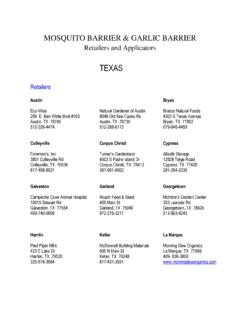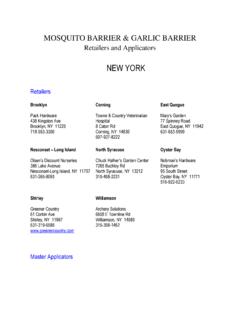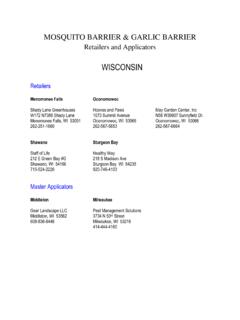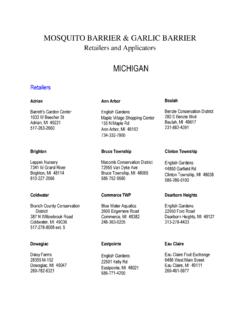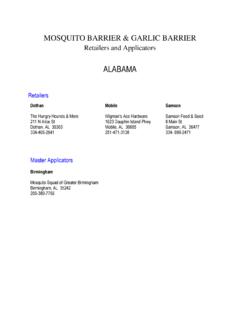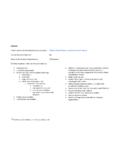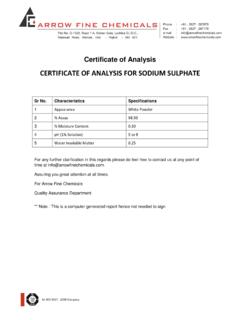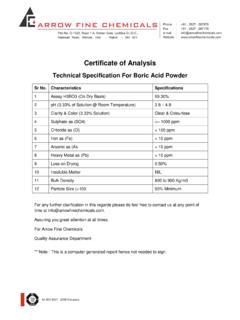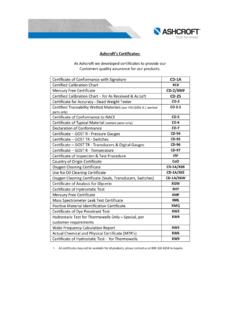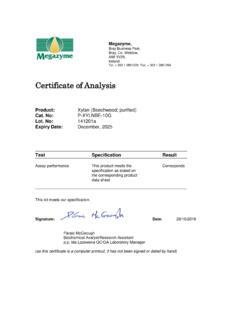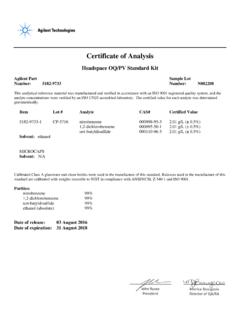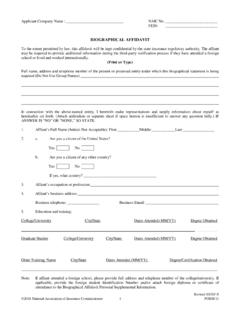Transcription of Certificate of Analysis Africa, Ltd November 5, 2007
1 Certificate of Analysis : Allyl Sulfides and Allyl Thiosulfinates before and after heating at 54 Degrees C for Two weeks. For: Mosquito Barrier International, under the funding and sponsorship of Mosquito Barrier Africa, Ltd November 5, 2007. Product: Mosquito Barrier garlic juice, made by Garlic Research Labs, Inc. Glendale, USA. The 32 oz bottle was received on October 11, 2007, but was manufactured on May 8, 2007. Result: Compound Amount before heating Amount after heating at % change due to 54oC for 2 weeks heating at 54oC. Micrograms/ml juice Mean SD, (RSD or CV as % (% of total ) for 2 replicate samples Diallyl Sulfide (DAS) 461 4( )[ ] 727 10 ( ) [ ] +56%. Diallyl disulfide (DAS2) 4140 60 ( ) [ ] 2990 80 ( ) [ ] -29. Diallyl trisulfide (DAS3) 1770 30 ( ) [ ] 2010 30 ( ) [ ] +13. Diallyl tetrasulfide (DAS4) 1250 14 ( ) [ ] 1480 15 ( ) [ ] +17. Diallyl pentasulfide (DAS5) 496 3 ( ) [ ] 536 1 ( ) [ ] +8. Diallyl hexasulfide (DAS6) 143 5 ( ) [ ] 160 2 ( ) [ ] +14.)
2 Allyl methyl trisulfide (AMS3) 9 (5) [ ] 8 (2) [ ] -6. Total Allyl Sulfides 8260 105 ( ) [100] 7910 130 ( ) [100] -5. Allicin (diallyl thiosulfinate) nd* nd* - Allyl methyl thiosulfinates nd* nd* - Allyl properlyl thiosulfinates nd* nd* - *nd = not detectable; limit of detection for all thiosulfinates = 1 microgram per mL juice Comments: Absence of allicin. The absence of allicin and other thiosulfinates was to be expected. Allicin in crushed raw garlic is unstable, with half-life of only about 3 days at room temperature, which can be extended some by the addiction of stabilizers. As allicin decreases, it is transformed to stable diallyl sulfides containing 1-6 linear sulfur atoms, of which DAS2 and DAS3 are the most abundant. A similar process occurs more rapidly when crushed raw garlic is steam-distilled to produce common garlic oil. Allyl sulfide changes. Heating at 54oC appears to have transformed about 29% of the diallyl disulfide (DAS2) to other diallyl disulfide.
3 Such changes are known to happen to allyl sulfides. The overall loss of allyl sulfides was only 5%. However, there might not be any loss of anti-mosquito activity, because DAS3-DAS6 increased, and these compounds may well have more activity than DAS2. Activity. The anti-mosquito activity of the various allyl sulfides is not known, but it is known that the allyl sulfides have antimicrobial activity that increases with the number of sulfur atoms. The relatively high abundance of DAS3-DAS5 in this product probably accounts for its reported anti . mosquito activity. Although allicin is regarded as the main antimicrobial compound of crushed raw garlic, the antimicrobial activity of steam-distilled garlic oil, with a composition similar to Mosquito Barrier, is known to have similar antibacterial activity to allicin. Allyl sulfides abundance. The content of allyl sulfides present in this sample of Mosquito Barrier garlic juice was higher then expected for typical garlic cloves.
4 Among a large number of garlic varieties tested, the highest value we have ever seen for crushed garlic was mg per gram, which could give an allyl sulfides content of about mq per gram, which is similar to the value found for this sample of Mosquito Barrier. Uniqueness of Mosquito Barrier: The composition of Mosquito Barrier garlic juice to be unique on at least two points. These features together make it very unlikely that this product could ever be mimicked. The unusually high content of allyl sulfides ( mg/mL garlic juice). The content of allyl sulfides present in this sample of Mosquito Barrier garlic juice was higher than expected for typical garlic cloves. Typical crushed garlic cloves contain about mg of allyl thiosulfinates per gram, which upon steam-distillation would produce about mg of allyl sulfides per gram. I have analyzed over 80. varieties of garlic. The highest value I have ever seen for crushed garlic was mg allyl thiosulfinates (mainly allicin) per gram, which could give an allyl sulfides content of about mg per gram, similar to Mosquito Barrier.
5 The almost complete absence of allyl methyl trisulfide (AMS3). AMS3 typically represents 15% of the total allyl sulfides content of garlic oils (garlic juice becomes garlic oil upon standing). Of the 15. brands of garlic oils I have analyzed, the lowest value I have seen for AMS3 is of total allyl sulfides, which is over 25 times lower than what I found in Mosquito Barrier ( ). Its presence is due to the fact garlic cloves contain both alliin and methiin, which form allyl methyl thiosulfinate upon crushing the cloves, and then AMS3 upon standing. Of the over 80 varieties of garlic I have analyzed the lowest methyl/allyl ratio I have ever seen was , but for Mosquito Barrier, the ratio I found was , which is 100 times smaller. Truly, Mosquito Barrier is made from a very unique strain of garlic. General methodology. Allyl disulfide by HPLC using modification of method #1480 (see reference 1991b). Allyl thiosulfinates by HPLC using modification of method 1430B. (See reference 1991a).
6 Silliker, Inc is based in Homewood, Illinois. It has 42 laboratories in 13 countries, Silliker provides consulting, testing, auditing, research and education services that help assure food and nutrition worldwide, Go to to learn more about our food safety and quality solutions. Silliker, Inc. is certified by and operates to ISO 17025. Analysis experience and literature references: The Analysis of Mosquito Barrier was conducted solely by Larry D. Lawson. He has been conducting analytical and pharmacological research of garlic since 1988. Resulting in 28 scientific publications. Below is a list of those publications relating to the Analysis of garlic thiosulfinates and sulfides. 1991a. Lawson, S. G. Wood, and Huges, HPLC Analysis of Allicin and Other Thiosulfinates in Garlic Clove Homogenates. Planta Medica. 57 (1991) 263-270. 1991b. L. D. Lawson, Wang, and Hughes, Identifation and HPLC Quantitation of the sulfides and Dialky Thiosulfinates in Commercial Garlic Products.
7 Planta Medica 57 (1991)363-370. 1992a. Hughes and Lawson. Antimicrobial Effects of Garlic, Onion, Garlic Compounds, and Commercial Garlic Supplement Products. Phytotherapy Res. 5(1992)154-158. 1992b. Lawson, Ransom, and Hughes, inhibition of Whole Blood Platelet Aggregation by Compounds in Garlic Clove Extracts and Commercial Garlic Products. Thiombosis Res. 65(1992)141- 156. 1992c. Lawson and Hughes, Characterization of the Formation of Allicin and other Thiosulfinates from Garlic, Planta Medica, 58(1992) 345-350. 1995. J. Han, Lawson, G. Han and Han, A Spectrophotometric Method for Qauntitative Determination of Allicin and Total Garlic Thiosulfinates. Analyt. Biochem. 225 (1195)157-160. 1996. Koch and Lawson, GARLIC: The Science and Therapeutic Application of Allium sativum L. and Related Species, Williams & Wilkins , Baltimore (1996), 340 pages, 2580 references. 1997. Lawson and E. Block, Comments on garlic chemistry; stability of S-(2-propenyl) 2-propene- 1-sulfinothioate (allicin) in blood, solvents, and simulated physiological fluids.
8 J. Agric. Food Chem. 45, (1997) 542. 1998 Lawson Garlic: A review of Its Medicinal Effects and Indicates Active Compounds in Phytomedicines of Europe: Chemistry and Biological Effects, Lawson and R. Bauer, eds., ACS. Symposium Series 691. American Chemical Society, Washington DC (1998), 176-209. 2001a. Lawson, Wang. D. Papadimitriou, Allicin release under stimulated gastrointestinal conditions from garlic powder tablets employed in clinical trials on serum cholesterol, Planta Medica 67. (2001) 13-18. 2001b. L. D. Lawson, Wang, Low allicin release from garlic supplements: a major problem due to the sensitivities of alliinase activity. J. Agric. Food Chem. 49 (2001) 2592-2599. 2005a. Lawson, Wang Allicin and Allicin-derived compounds from garlic and garlic products increase breath acetone through their common metabolite, allyl methyl sulfide; use of breath allyl methyl sulfide to measure allicin bioavailability, J. Agric. Food Chem. 53 (2005) 1974-1983. 2005b. Lawson, Gardener, Composition, stability, and bioavailability of garlic products used in a clinical trial, J.
9 Agric. Food Chem. 53 (2005) 6254-6261. SILLIKER, Inc. UTAH. LABORATORY. 95 South Mountain Way OREM, UTAH USA.
